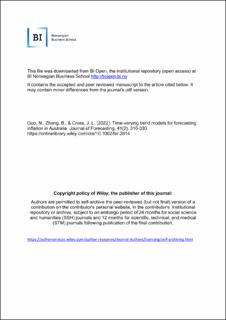| dc.contributor.author | Guo, Na | |
| dc.contributor.author | Zhang, Bo | |
| dc.contributor.author | Cross, Jamie | |
| dc.date.accessioned | 2023-08-18T12:19:29Z | |
| dc.date.available | 2023-08-18T12:19:29Z | |
| dc.date.created | 2021-09-15T14:07:29Z | |
| dc.date.issued | 2021 | |
| dc.identifier.citation | Journal of Forecasting. 2021, 24 (2), 316-330. | en_US |
| dc.identifier.issn | 0277-6693 | |
| dc.identifier.uri | https://hdl.handle.net/11250/3084841 | |
| dc.description.abstract | We investigate whether a class of trend models, which decompose a time series into an underlying trend and transitory component, with various error term structures can improve upon the forecast performance of commonly used time series models when forecasting consumer price index (CPI) inflation in Australia. The main result is that trend models tend to provide more accurate point and density forecasts at medium to long forecasting horizons compared with conventional autoregressive and Phillips curve models. The best medium‐term point forecasts come from a trend model with stochastic volatility in the transitory component and that with a moving average component, whereas long‐run point forecasts are better made by trend models with stochastic volatilities and a moving average component. In a full sample study, we also find that trend models can capture various dynamics in periods of significance to the Australian economy which conventional models cannot. This includes the dramatic reduction in inflation when the RBA adopted inflation targeting, a one‐off 10% Goods and Services Tax inflationary episode in 2000, and then gradually decline in inflation since 2014 | en_US |
| dc.language.iso | eng | en_US |
| dc.publisher | Wiley | en_US |
| dc.subject | trend model | en_US |
| dc.subject | inflation forecast | en_US |
| dc.subject | Bayesian analysis | en_US |
| dc.subject | stochastic volatility | en_US |
| dc.title | Time-varying trend models for forecasting inflation in Australia | en_US |
| dc.title.alternative | Time-varying trend models for forecasting inflation in Australia | en_US |
| dc.type | Peer reviewed | en_US |
| dc.type | Journal article | en_US |
| dc.description.version | acceptedVersion | en_US |
| dc.rights.holder | Wiley | en_US |
| dc.source.pagenumber | 316-330 | en_US |
| dc.source.volume | 24 | en_US |
| dc.source.journal | Journal of Forecasting | en_US |
| dc.source.issue | 2 | en_US |
| dc.identifier.doi | 10.1002/for.2814 | |
| dc.identifier.cristin | 1934583 | |
| cristin.ispublished | true | |
| cristin.fulltext | postprint | |
| cristin.qualitycode | 1 | |
